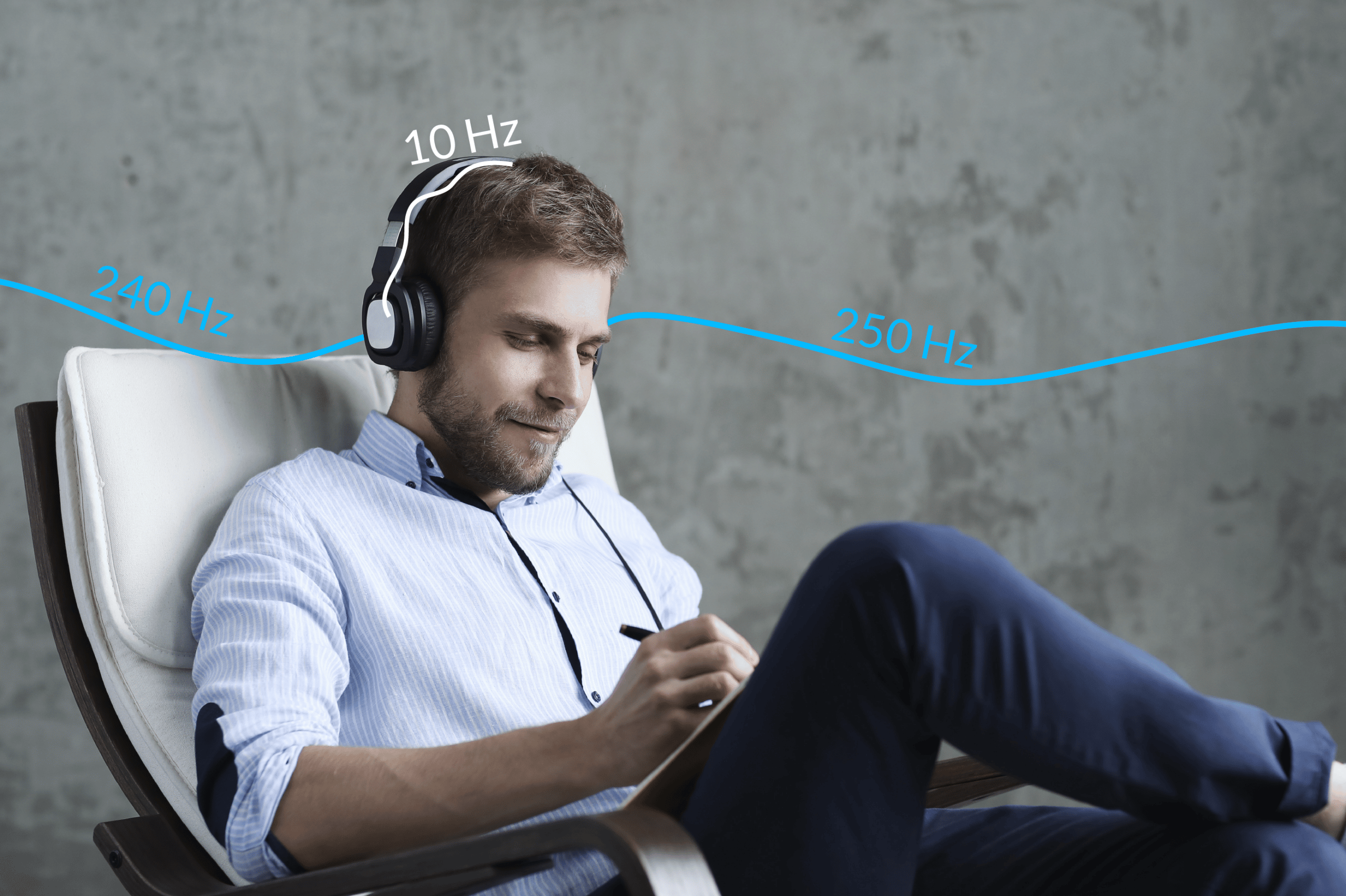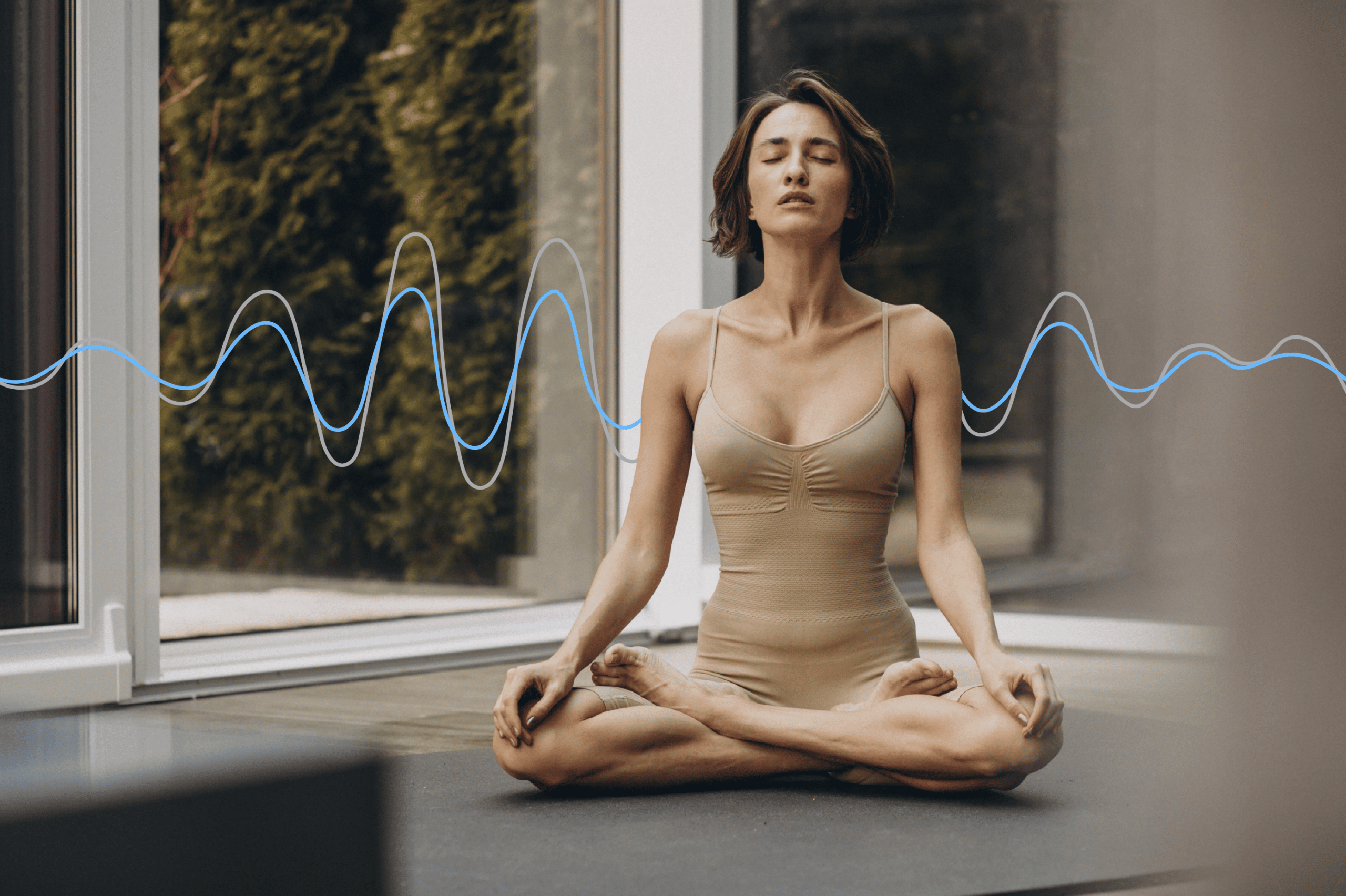Using brainwaves to improve your mental state and reduce stress
Every action we engage in has a biological component. Our brain activity during sleep is not the same as when we rush through a stressful exam. Most of the time, our behaviours and emotions directly influence the neurochemical reactions that happen inside our brains. Knowing this, is there a way we can ‘manipulate’ our biology to improve our mental health and have a better life?
Brainwaves, the language of the brain
Table of Contents
Brainwaves result from the electrical activity between neurons. These are specialized cells that communicate with each other and create an electrical activity that can be now measured with technology such as EEG (electroencephalograph). These brain waves are split into 5 major categories – gamma, beta, alpha, delta, and theta – although each frequency band can have its sub-categories (such as high or low beta).
Depending on the type of activity we perform, our brain will generate a predominant brain wave activity – for example, presenting a speech in front of a group of people generates high mental activity in the form of high beta frequencies. Sleep is often associated with a preponderance of alpha, delta and theta brain waves, which are the lowest in frequency.
Therefore, knowing how brain waves function can empower us to engage in activities and practices that enhance our mental well-being.
Beta waves: getting things done
Beta activity is ‘fast activity’. It is often present when we are involved in deep problem-solving, or focus on activities that require intense cognitive effort. For example, students who are highly focused in class will display many beta waves as this type of task engages their active thinking. Similarly, performing your job will also cause your brain to produce fast beta activity, which helps you get things done and stay focused for a longer period of time.
How can you increase your beta waves?
One simple way you can enhance the beta waves in your brain — and increase your productivity — is to listen to beta binaural beats. These are songs with two beats that are played at each ear at different frequencies. For example, the left ear might have a tone tuned to 200Hz and the right one to 220Hz. The 20 Hz difference in beats will induce the brain to produce specific beta waves that help you stay in the flow while you focus on a task.

Can we have too many beta waves?
Since beta waves are associated with intense brain activity, producing too many of them is linked to high stress and anxiety. In our modern world, many people spend a lot of time on high alert, aiming to get as many things done as possible. Producing too many beta waves without allowing ourselves adequate time for rest can make us feel anxious and irritable, and can also lead to sleep problems. EEG studies have shown that anxious and highly stressed people have intense beta wave activity and little alpha and theta waves, which are necessary for rest in recovery.
Alpha waves and relaxation
Alpha waves typically measure between 8 and 12 Hz when people feel relaxed and there is low brain activity. These waves have been found by research studies to play a key role in creativity, mental illness, and relaxation. The brain is able to produce alpha waves when it is in an idle state without doing any stress-inducing activities. Therefore, anyone can induce the production of alpha waves that allow them to achieve mental relaxation or engage in creative, non-focused thinking.
Alpha wave activity is essential to our mental well-being thanks to a number of reasons. A study published in the journal Translational Psychiatry found that this brain wave is associated with reduced depressive symptoms in people with major depressive disorder. In other words, getting our brains to produce more alpha wave patterns can lead to fewer depressive symptoms. Another interesting research finding has shown that alpha waves are associated with increased creativity. When we’re in a relaxed state, we might be able to find creative solutions to our problems or come up with innovative ideas simply because our brains are not populated by noisy cognitive activity.
How can we increase alpha wave activity?
Besides using tools like biofeedback or EEGs, there are other simple and less expensive ways to get into a relaxed alpha state. For example, meditation has been shown to promote increased alpha brain activity, while also reducing symptoms of depression and anxiety. You can also incorporate practices such as deep breathing, yoga, or aerobic exercise into your routine. These have been shown to play a crucial role in mental well-being while promoting the mental relaxation associated with higher alpha brain activity.

Rewiring your anxious brain with biofeedback tools
Many people who suffer from various forms of anxiety (social anxiety, generalised anxiety disorder, and other stress-related disorder) can have increased activity in the frontal brain areas. This can show up as an excess of beta brain waves, which are high-amplitude frequencies that result from intense mental activity.
When these brain waves are predominant, they can impair mental functioning, making it difficult for someone to stay focused on their task or relax. They might have automatic negative thoughts or might feel that their thoughts spiral out of control.
There are now multiple resources in place that can help individuals struggling with anxiety. People can benefit from medical treatments, psychotherapy interventions, counselling, and behavioural interventions. More recently, neuroscientists have begun to look into a novel intervention technique based on biofeedback. This intervention called neurofeedback has been studied by recent research as an adjuvant treatment in mental health conditions such as depression, anxiety and traumatic brain injury.
Neurofeedback works according to the principle of operant conditioning and aims to change the basic physiology of the brain. It provides feedback in real-time about the activity of the brain waves of the patient while they engage with a stimulus either in a video or audio format. Many neurofeedback protocols entail playing a video game on a computer, and when the patient meets their desired cognitive performance activity, they are able to progress in the game.
Whenever the patient is able to reach their goals, they reinforce new neural connections in their brain, creating lasting change in their physiology. It is important to note that neurofeedback is not a treatment for mental illness. It does not cure long-lasting or chronic mental illness but merely works as an efficient adjuvant treatment that can optimise other behavioural, medical, or psychotherapeutic interventions.
Instead, neurofeedback allows the brain to witness its own activity and use the feedback provided for better self-regulation. Better self-regulation skills promote better brain functioning and implicitly a higher cognitive performance. Neurofeedback does not treat anxiety completely, nor does it repair the pattern of brain waves. Instead, it supports and empowers the client in finding their path toward more efficient self-regulation and consequently towards a better quality of life and mental performance.
Studies show that participants with generalized anxiety symptoms (GAD) taking part in randomized controlled trials show statistically significant improvements in their symptoms compared to no-trial conditions. For example, a single randomized controlled trial showed a reduction in PTSD symptoms when neurofeedback interventions were delivered alongside other forms of treatment for this mental health condition.
Key takeaways
Knowing how to reap the benefits of all brain waves can enhance your mental wellbeing. This is possible by incorporating practices in your routine that help you get in the desire state depending on your goals. For example, if you want to focus and get productive for the day ahead, you may find that increasing your beta waves will speed up your mental skills. You can do that by looking for music with binaural beats online which you play while working or studying.
If your goal is to achieve a calmer state of mind, you will want to increase your alpha waves instead. Practices like meditation, deep breathing techniques, yoga, or working out will shift your brain into a more relaxed and grounded state. When you have more alpha patterns in your brain activity, you will also be able to find more creative solutions or see the ‘bigger picture’.
References
Ribas VR, Ribas RG, Nóbrega JA, da Nóbrega MV, Espécie JAA, Calafange MT, Calafange COM, Martins HAL. ‘Pattern of anxiety, insecurity, fear, panic and/or phobia observed by quantitative electroencephalography (QEEG)’. Dement Neuropsychol. 2018 Jul-Sep;12(3):264-271.
Alexander ML, Alagapan S, Lugo CE, et al. Double-blind, randomized pilot clinical trial targeting alpha oscillations with transcranial alternating current stimulation (Tacs) for the treatment of major depressive disorder (Mdd). Transl Psychiatry.
Fernandez-Duque, D., Evans, J., Christian, C., Hodges, S. “Superfluous neuroscience information makes explanations of psychological phenomena more appealing.” Journal of Cognitive Neuroscience, 27(5), 1-19
Lustenberger C, Boyle MR, Foulser AA, Mellin JM, Fröhlich F. Functional role of frontal alpha oscillations in creativity. Cortex. 2015;67:74-82.
Lagopoulos J, Xu J, Rasmussen I, Vik A, Malhi GS, Eliassen CF, Arntsen IE, Saether JG, Hollup S, Holen A, Davanger S, Ellingsen Ø. Increased theta and alpha EEG activity during nondirective meditation. J Altern Complement Med. 2009;15(11)
Banerjee S, Argáez C. Neurofeedback and Biofeedback for Mood and Anxiety Disorders: A Review of Clinical Effectiveness and Guidelines [Internet]. Ottawa (ON): Canadian Agency for Drugs and Technologies in Health; 2017 Nov 13.
Reiter K, Andersen SB, Carlsson J. Neurofeedback Treatment and Posttraumatic Stress Disorder: Effectiveness of Neurofeedback on Posttraumatic Stress Disorder and the Optimal Choice of Protocol. J Nerv Ment Dis. 2016 Feb;204(2):69-77
Disclaimer
NeoRhythm has not been evaluated by the FDA. These products do not claim to diagnose, treat, cure, or prevent any medical conditions. Always consult your medical doctor regarding any health concerns.
